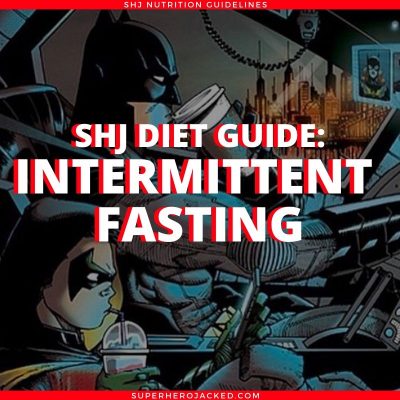Last updated on April 3rd, 2023 at 06:06 pm

If you haven’t realized already: The SHJ Army utilizes intermittent fasting.
We’ve talked about it numerous times before, and now I’m here to expand on it.
In my research I have now studied the workouts and diets of over 300 celebrities, athletes and the world’s top performers.
A handful of celebrities that swear by intermittent fasting are guys like: Hugh Jackman, Terry Crews, Dwayne Johnson, Chris Pratt, and more.
I also broke down a list of Ten Celebrities that Utilize Intermittent Fasting, for those of you wanting more – but more interesting is the full list of The Top Diets Used Among Celebrities.
The latter holds a lot of the information I break down into case studies within my book Superhuman Secrets and how I came to build our overall 4-Tier-Nutrition System.
Which, if you’re here for the 4-Tier Nutrition System we use at SHJ you should start by reading these other three articles, which are all part of it, in conjunction with the one you’re currently on!
You can take a full course on all of my research and a breakdown of our 4-Tier-Nutrition System, with much more depth than these articles (and our exclusive calculators, recipe index, fast food index, and more) within our Academy.
We know there are tons of different options for fasting, and mainly I just cover the specific format we like to work our way up to here at Superhero Jacked.
In this article, however, I think it’s important to cover all the bases and talk about all different formats of intermittent fasting.
But wait…What the HECK is Intermittent Fasting?
Seriously… What is intermittent fasting?
Oh, right.
That’s probably a good place to start.
Let’s break it down a bit first before we get ahead of ourselves.
The definition Google gives us for intermittent is:
occurring at irregular intervals; not continuous or steady.
And the definition Lord Google gives us for fast is:
abstain from all or some kinds of food or drink, especially as a religious observance.
Leaving us with what Wikipedia tells us intermittent fasting is:
is an umbrella term for various diets that cycle between a period of fasting and non-fasting.
Alright, c’mon that was a pretty sweet jab, jab, hook…eh?
A nice Google, Google, Wiki, combo?
But let me sum it up for you even more:
Intermittent fasting is when we make a conscious effort to stop eating for a specific period of time, starting and stopping between our eating and non-eating windows in order to manipulate our dieting cycle. This leaves us with health benefits and other factors that prove to be great for our overall physique as well.
Did you just have an ah ha moment?
Because that would be awesome if I made that happen…

The Different Formats of Intermittent Fasting
There are some simple different variations of intermittent fasting that are all being utilized to great success.
The differences between them are what make certain people choose one over the other, though.
Lets take a look:
- The type of “short-term” fasting we utilize at Superhero Jacked:
- These fasts normally last between the 14-18 hour range, with a 6-10 hour eating window.
- This is what we’ve seen guys like Hugh Jackman and Terry Crews utilize.
- The “one large meal” fasts (slightly longer):
- These fast periods generally last 20+ hours and revolve around one large meal per day.
- The fasting window is large (like I said 20+ hours) and the eating window is very small; generally 1-4 hours.
- The full day fasts:
- These fasts are for a full 24+ hour time span.
- Generally people do this once, or sometimes even twice a week, and they last 24+ hours.
These have all proven to be effective methods, but have their own specific drawbacks as well. Through my own experimentation I find that I can easily use the first and second method, but the third (full day fast) generally isn’t sustainable for me.
And we know sustainability is absolutely crucial!
Without sustainability is it really a diet? And, is it really going to get you to your goal? Maybe…but it won’t last..

What can I eat and drink during my fast?
Ah, yes, I’m sure this is the first question you have.
Before what it actually does to your body, right? Maybe not, but lets go through it anyway.
What you CAN and CANNOT eat/drink during your fast is pretty simple.
What you CAN eat/drink:
- Black coffee
- Tea
- Zero calorie drinks
- Water
- Club soda and other zero calorie carbonated drinks
What you CANNOT eat/drink:
- Everything else…
- Anything with calories
- This includes:
- Carbs/Proteins/Fats
FUN FACT: We also know that Hugh Jackman got his diet from Dwayne “The Rock” Johnson, and follows intermittent fasting the same way we do – using it to bulk up while staying lean for Wolverine!
**Skip to about 1:45 of this video**

How does intermittent fasting work – and what does it do?
In order to explain how intermittent fasting works, we’re first going to have to explain how our body utilizes energy.
When you eat food, regardless of what it is, your body is going to try use that as a source of energy. Everything you ingest is fuel for your body, just some things effect it differently.
Okay here’s where it gets fun though….
Pay attention, because this part is important:
If you eat too many unused calories, your body stores the extra as fat.
Similarly, if you don’t have enough calories, but you need energy, your body uses the excess fat storage as energy.
BOOM!
So, when we’re eating all day long as opposed to an intermittent fast, we’re apparently giving our body the fuel it needs to get the job done. But, if we are fasting all day, our body needs to find a way to react and find energy elsewhere. That’s why intermittent fasting is great for fat burning. Our body will look to our excess fat storage as a way to find the energy we need to get us through our fasts.
But now I’m sure you want to know what else intermittent fasting does for you, right?
Good, because it gets better.
Here’s what Precision Nutrition tells us about the other benefits of intermittent fasting:
REDUCED
- blood lipids (including decreased triglycerides and LDL cholesterol)
- blood pressure (perhaps through changes in sympathetic/parasympathetic activity)
- markers of inflammation (including CRP<, IL-6, TNF, BDNF, and more)
- oxidative stress (using markers of protein, lipid, and DNA damage)
- risk of cancer (through a host of proposed mechanisms; we’ll save them for another review)
INCREASED
- cellular turnover and repair (called autophagocytosis)
- fat burning (increase in fatty acid oxidation later in the fast)
- growth hormone release later in the fast (hormonally mediated)
- metabolic rate later in the fast (stimulated by epinephrine and norepinephrine release)
IMPROVED
- appetite control (perhaps through changes in PPY and ghrelin)
- blood sugar control (by lowering blood glucose and increasing insulin sensitivity)
- cardiovascular function (by offering protection against ischemic injury to the heart>
- effectiveness of chemotherapy (by allowing for higher doses more frequently)
- neurogenesis and neuronal plasticity (by offering protection against neurotoxins)
Let’s just pull some of that out: Increased fat burning, growth hormone release and metabolic rate while also improving my appetite and blood sugar control, and cardiovascular function.
Uh, yes please!
I’ll take it all, but if just that sentence alone didn’t sell you I’m not sure what will!

Can I workout fasted?
Yup!
I workout fasted every single day. I’ve even experimented with working out after 24+ hour fasting periods and I’ve had more success and energy training than I did during a regular eating schedule workout.
Don’t believe me?
Tim Ferriss did a podcast interview titled “Dom D’Agostino on Fasting, Ketosis, and the End of Cancer” in which Dom talks about his training fasted experiments.
“Dr. Dominic “Dom” D’Agostino is an Assistant Professor in the Department of Molecular Pharmacology and Physiology at the University of South Florida Morsani College of Medicine, and a Senior Research Scientist at the Institute for Human and Machine Cognition (IHMC).
And, Ferriss tells us that he (Dr. Dom): “has also deadlifted 500 pounds for 10 reps after a seven-day fast.”
I mean, c’mon people! Now it’s not just me spitting out some random words at you. This is some real deal fasting and training badassery…
In a guest article we had by Kyle Hoffman he explains:
Well, now there’s evidence that training fasted increases an important muscle growth indicator called p70s6 kinase. In fact, in this study, participants who trained immediately after sleeping (without any breakfast) had 2x the normal amount of this indicator than those who trained on a full stomach.
Fasted training wins again!
This evidence isn’t that of a long 24+ hour fast, but more-so to show you guys that training fasted is not only possible, but also proven to give amazing results.
Do I workout fasted?
Yes. I personally prefer working out fasted.
I will talk more about my personal fasted window below, but a quick synopsis of it is:
Fasted 8pm-2pm and train somewhere between 10-2, breaking my fast roughly 1-2 hours after.
I find that I can increase the intensity of my workouts more, and I just get a better overall session in if I am fasted.
This is a personal preference, but one that I find more and more members of SHJ turning to as they begin working IF into their nutrition systems.

Full Disclosure: Why do we use Intermittent Fasting at SHJ?
The real reason we utilize intermittent fasting at SHJ is for hunger control and appetite suppression.
When I first tell people that some of them gasp because it does seem a little backwards.
“Mike, you’re telling me I can control my hunger by NOT eating…!?”
Yes. That’s exactly what I’m telling you.
When you begin using intermittent fasting, in any level (whether that’s 14 hours or 18 hours a day, or working your way up to a specific range you feel comfortable at) your body is going to be used to your fasting period and you will find that you run better on whatever it is you’re drinking during your fasted period.
I personally drink black coffee with zero calorie sweetener, or Monster Ultras during my fast.
I have been fasting for YEARS, and the appetite suppression and hunger control is just as strong, if not stronger than when I first started years ago.
Here’s an example:
- Example A: Stick to My Fasted Schedule
- Fast 8pm-2pm.
- Break fast somewhere between 2-3pm after workout.
- Full for HOURS from big meal. Eventually have a big protein shake or other “go-to” snack/meal.
- Full again until 6-8pm where I have a final big meal, with leftover calories to treat myself.
- Example B: Break My Fast Early
- Eat Breakfast upon waking up at 7-8AM.
- Hunger starts.
- Eat. Eat. Eat More. Hungry. Eat.
If you don’t get the examples, here’s what happens: when you start eating, you kickstart your hunger and you have all day to eat within your caloric window, which we discussed in The SHJ Guide to Calorie Counting (which also happens to be a main tier within our 4-Tier-Nutrition System).
Conversely, if you DON’T start eating, then you don’t kickstart your hunger and you train yourself (by forming the habit and your body adjusts to the schedule accordingly) to fast through those hours, never having to worry about hunger striking you down like Hades.

Getting Started With Intermittent Fasting
I mentioned three different types of intermittent fasting schedules above, but now I’m going to break down three different windows of fasting within the shortest type that we analyzed.
Here’s what I mean: we’re going to disregard the two longer fasting periods I told you about above, and I’m going to take you through 3 different periods of fasting that we utilize within our Academy to move members through the most effective intermittent fasting schedules and windows.
This is our fasting ladder that we use within our 4-Tier Nutrition System:
- LEVEL ONE: 14 Hour Fasting Window, 10 Hour Eating Window
- LEVEL TWO: 16 Hour Fasting Window, 8 Hour Eating Window
- LEVEL THREE: 18 Hour Fasting Window, 6 Hour Eating Window
Sometimes that can seem daunting, and that’s understandable.
BUT, I promise you: it shouldn’t be.
That Seems WAY Too Long…!
Let’s take a look at a Level One Schedule:
- Stop Eating 10PM
- Sleep 6-9 Hours
- Wake Up 6AM-10AM
- Start Eating 12PM
Yes, sleep counts in your fasting schedule!
A lot of times people think 14 hours seems like a scary way to get started, but in reality you’re likely only skipping breakfast by a few hours and starting with your morning coffee, tea or water on its own instead.
Working up from there becomes super easy by just playing around on either end of your schedule.
I personally don’t like eating too closely to when I’m going to sleep, so if you’re the same way you could easily stop eating at 8PM on that schedule and all of a sudden you’re already at Level Two!
My Personal Intermittent Fasting Schedule
My personal intermittent fasting schedule adheres to Level 3.
It’s not that far off of what I explained above, but I add two hours before bed (I stop eating at 8PM), and tack on two hours before I start eating (I usually start eating around 2PM).
So my schedule GENERALLY looks like this:
- Stop Eating 8PM
- Sleep 6-9 Hours
- Wake Up 6AM-10AM
- Start Eating 2PM
If I’m on vacations or with family or celebrating something, I do fluctuate this and don’t have to stick to a super strict regime.
For myself, and within SHJ guidelines, I do not believe in a diet that gets to control your lifestyle. That’s not sustainable, and that isn’t how life should be (and it doesn’t have to be).
On top of this, I work within a 17-19 hour range fairly loosely.
Sometimes I’ll stop eating at 9PM, other times I forget to eat because of work and training and I start at 3-5PM.
Basically, life happens, but intermittent fasting allows me to control my hunger how I need to best adhere to the other 3 tiers of our 4-Tier Nutrition System (one of which is literally daily indulgences).

We Love Having Three Different Levels To Work With
One thing you’ll notice about SHJ and our tactics is that I build all our systems around being the most effective, efficient and sustainable ways to do things.
I focus in on what really matters and then I form them in a way that is easily adjustable FOR YOU.
That means that my diet and your diet don’t have to look alike for us to achieve incredible results.
The same goes for our training.
That’s why I have three different levels of intermittent fasting AND three different levels of daily protein intake for members to choose from within our Academy and SHJ Systems.
Here, let’s take a deeper look at what I mean by zooming in on our 4-Tier Nutrition System again:
- Overall Daily Calories (Read SHJ Guide to Calorie Counting)
- Eat above or below your specific BMR (or metabolism), calculated by our calculators within our systems – depending on your goal.
- Daily Protein Goal (Read SHJ Guide to Protein Intake)
- Level One:
- Level Two:
- Level Three:
- Intermittent Fasting (You’re reading the right article)
- Level One: 14 Hour Fast
- Level Two: 16 Hour Fast
- Level Three: 18 Hour Fast
- Daily Cheat Meals and Indulgences (Read SHJ Guide to Cheat Meals and Indulgences)
- Daily indulgences built into your specific nutrition plan based on your goals and intake.
Point being: we like to keep things simple, effective, and easily adjustable for all of our members – so don’t think you have to make your system exactly like mine.
We’ll be following the same guidelines, but our actual diet plan can look drastically different!
Final Thoughts on Intermittent Fasting
Let me start by saying that I am an avid supporter of intermittent fasting, but I want it to be VERY clear:
- This is not a magic system to weight loss.
- This will not allow you to eat more calories than if you were not utilizing it.
- This will not allow you to burn fat without being in a caloric deficit (nothing will).
- This is an OPTIONAL tier within our 4-Tier-Nutrition System that can (and likely should) be added in for additional control over your appetite.
I know some people think intermittent fasting falls into a “fad diet” category, and I completely understand why.
There are fitness influencers and trainers out there making it seem like it is a magic pill to success, like they do with most things that are going to make techniques look “sexy” or “shiny object”.
It’s similar to what I write about within two of my favorite resources here at SHJ:
- The Four Key Components of Your Transformation
- The Two Main Reasons You Are Not Transforming Your Physique
There are such simple tactics to achieve what we see from thousands and thousands of celebrities within our Workout Database, but they seem almost too simple to be real.
But, I challenge you to give them a shot.
Show up every day. Get moving. Have fun. find what works for you.
######
Mike Romaine
SHJ’s Nick Fury
Join The Superhero Academy and start unleashing your inner SuperHuman.

SUPERHUMAN SECRETS V.2
NOW UPDATED AND EXPANDED WITH A NEW SECTION & SEVEN BONUSES
USD$29 USD$14.95


Is Intermittent Fasting also suggested for women? I see it mentioned in several men’s articles, but I’m curious about applying it for myself. Additionally, will it be successful if I’m working out in the evening, so not performing fasted cardio.
Thanks!!!
Hey Sarah,
Sorry for the delayed response.
In The Academy I have women vary the intermittent fasting if they’re not utilizing SuperHuman Fuel (bulletproof coffee variations) so that they fast, don’t fast, fast, or fast for two days, then do protein only in the morning another day, etc. It’s varied up so it’s not a constant 7 days a week only because I’ve read research that the persistent fast can effect SOME women’s hormones.
Mike
When you do your fasting schedule do you eat the bulk of your carbohydrates during your first meal aka post workout? If you do is your last meal fairly low carb?
No. Intermittent fasting isn’t magic. It’s just great for controlling your hunter and over caloric intake. Doesn’t matter if you have all your carbs right off the bat or right at the end. As long as you end in a deficit for weight loss.
So to clarify even if your doing your workout fasted having a low carb meal afterward won’t matter much as long as you have carbs in your last meal later in the day and you are in a deficit?
To clarify: The most important things are daily caloric intake for fat loss/mass gain (in a deficit to lose weight, and surplus to gain weight) and daily protein intake for muscle retention and gains.